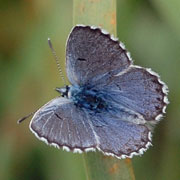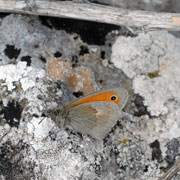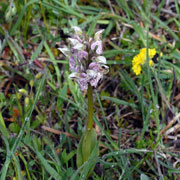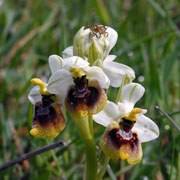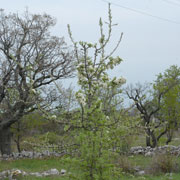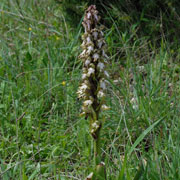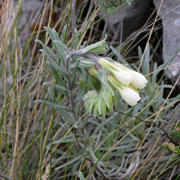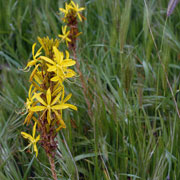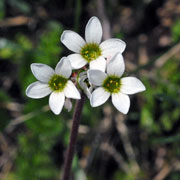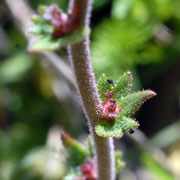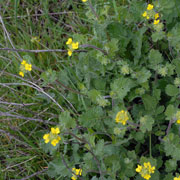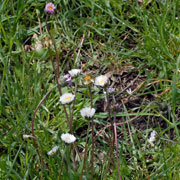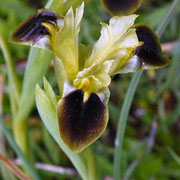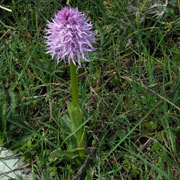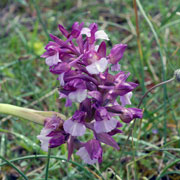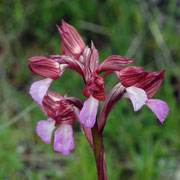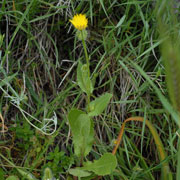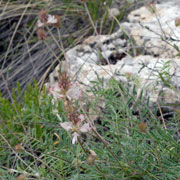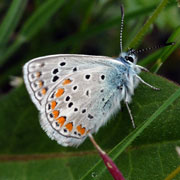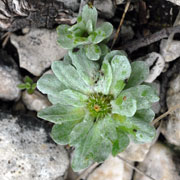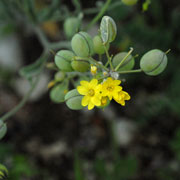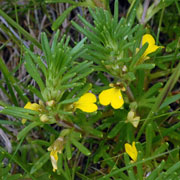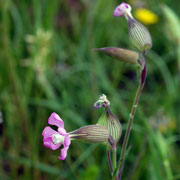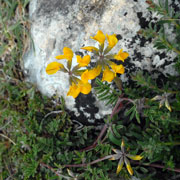Only a short way up the same road a series of small enclosed fields held different botanical treasures in each. We soon found early flowering Orchis purpurea (Lady Orchid) with much darker upper floral parts than those we find in southern England but it was only just beginning to flower so this orchid is shown later on. Nearby a new Orchid was discovered again in large numbers and this one turned out to be Orchis lactea (Milky Orchid). Each field was surrounded by a fence of some sort usually barbed wire but rather loosely attached. This provided no obstacle for Orchid hungry botanists keen to compensate for the decidedly northern European weather. Opposite the Lady Orchids stood a huge Orchid - the largest we found on the trip. This was Barlia robertiana (Giant Orchid) which close up has undistinguished rather dull greeny pink flowers but from a distance is quite impressive. We were informed that Barlia robertiana had changed its name to Orchis robertiana but I suspect it was the taxonomists who changed it really. In any case however taxonomically accurate the new name may be, the world hasn't caught up yet and Google produces ten times as many hits for Barlia robertiana as it does for Orchis robertiana.
Taxonomists are always researching species to find if they have been classified correctly but it doesn't necessarily lead to clarification. In the late 1990s work was done by Professor Bateman et al. which showed that the Orchis morio (Green-winged Orchid) we saw earlier in the day was really a member of the Anacamptis genus. It should, according to their genetic research, be called Anacamptis morio. So new books on Orchids sometimes use these new names but others still stick to the old names. Our leader took a view on the naming of Orchids which was backed up by another Orchid expert but not necessarily the same as the views of other experts. So occasionally I have put another name in brackets to show that some experts call the plant by a different name. Usually though, and this is a very useful aspect of naming plants, the commonest English name has remained untouched by taxonomists over the years. So Green-winged Orchid still remains Green-winged Orchid just as it was fifty or more years ago regardless of the disagreements about its systematic (Latin) name.
Further up the path little groups of botanists could be heard ooohing and aahhing at various flowers, we found some extraordinarily large and dark Orchis morio (Green-winged Orchid) nothing at all like the demure little species we see at home. An unfamiliar yellow light suddenly bathed the fields in warmth and we realised that the sun does sometimes shine in Italy. This prompted butterflies to start appearing and a Brown Argus (Plebeius agestis), Baton Blue (Pseudophilotes baton), Common Blue (Polyommatus icarus), Orange tip (Anthocharis cardamines) and Small Heath (Coenonympha pamphilus) we seen by me with others claiming to have seen a Swallowtail (Papilio machaon).
A Saxifrage nearby looked very like our Saxifraga granulata (Meadow saxifrage) but closer examination revealed that there were bulbils in the leaf axils and it was densely covered in glandular hairs. This was Saxifraga bulbosa (Bulbous Saxifrage) which we later saw in other places on the Gargano. In the grass of these small fields, often nearly hidden from view were some white flowers of the lily family. These Ornithogalum umbellatum (Star-of-Bethlehem) plants were growing much closer to the ground, perhaps because of the occasional grazing, than the ones we see in the British Isles.
The oddest plant we saw at this stop was a hybrid between Orchis morio (Green-winged Orchid) and Orchis papilionacea (Pink Butterfly Orchid). This was as large and wide as a Orchis papilionacea but had the greenish wings of Orchis morio. By the path there was a delicate pink flower with seeds which should make it straightforward to identify as I didn't recognise the plant at all. It was Aethionema saxatile yet I have seen it before. In the White Mountains (Lefka Ori) of western Crete it grows on the rocks of the Omalos plateau. In Crete it is a compact and low growing sub species cretica endemic to that island and nothing like the tall plants we saw at the Gargano. The ones we saw here logically should perhaps be known as ssp saxatile but I can find no reference to that. In one of the fields we discovered our first patch of Orchis italica (Naked Man Orchid). This turned our to be one of the commonest orchids on the Gargano with drifts of hundreds of them in some places. An orchid which I see regularly on trips to southern Europe is Ophrys tenthredinifera (Sawfly Orchid). Unlike the dark Ophrys species of O. garganica, O. promentorii and O. incubacea, this one is very colourful. However we found one which has white sepals and upper petals which added to its attractiveness.
A small tree with white blossom and thorns grew by the path. The shape of the leaves and colour of the bark suggested a Wild Pear (Pyrus sp) but the leaves appeared to be the wrong shape. However Pyrus amygdaliformis (Almond-leaved Pear) is very variable according to the various photos shown on the internet and I'm sure now that this was what we saw. This one was Sinapis arvensis (Charlock) which seemed so much hairier and less straggly than the familiar British arable weed. Another superficially familiar weed was growing into he grass but seemed far too tall to be a common daisy. This was Bellis sylvestris (Southern Daisy) the flower head of which looks very much like our British Bellis perennis (Daisy) but which seems much taller and more elegant than its British relative.
Is it me or are even the weeds classier on the Gargano?
Lunch Day1
Lunch was always a delight. Our leaders Mary and Joe went to shop first thing before breakfast and bought various local foods to provide choice, taste, texture and eye appeal. This time lunch was served from the back of the two hired vans which we used to travel around the Gargano and the rear of the vans were converted into food tables. There were at least three different kinds of cold meat accompanied by cheeses, fresh bread, fruit juice, water or wine with crisps, olives, tomatoes and other salad items and of course fresh fruit. We each brought our own plates and mugs for use with the picnics and happily consumed what usually turned out to be the best meal of the day. To add to the delight, one of our number recognising that in such cold, overcast conditions something stronger is needed, provided us all with a small plastic beaker of Grappa.
Grappa is a somewhat stronger drink than the wines provided by our leaders with a kick closer to Scotch but (to me) none of the refined taste. I imagine it is consumed at Monsa by petrolheads attending a Formula 1 Grand Prix or it might really be a secret fuel additive used by Ferrari. Nevertheless it was most welcome.
After lunch a few of us galloped up to the top of the track again where some new orchids had been found. These small delicate pink orchids with two obvious dots on the Labellum (lower lip) were Orchis quadripunctata (Four Spotted Orchid). This two spotted orchid has another couple of spots hidden from view hence the quadripunctata rather than bipunctata.
Sunday Afternoon 19th April 2009 Monte St Angelo Stop 3
The Santa Maria di Pulsano monastery is ancient and set into the hillside above some steep cliffs. Botany in southern Europe is very enjoyable but it's good to look at famous buildings too. So a few of us did go in to see the gloomy interior of this old building with its museum of ancient paintings. On the outside walls of the monastery there were plants and we couldn't resist using the binoculars (too high for photos) to identify the very poisonous Hyoscyamus albus (White Henbane) high up on a ledge and Cymbalaria muralis (Ivy-leaved Toadflax) lower down. Outside the rocks led to huge drops into the valley below but that didn't stop those of us with no fear of heights from going close to the edge to find one of the plants of the day: the endemic and rare Onosma lucana (Pale Goldendrops). Nearby was Hippocrepis glauca which is a Horshoe vetch with no English name but known locally as Sferracavallo glauco. In the grass near the monastery and right up to the edge of the cliffs were some tall yellow asphodel like plants. These were Asphodeline lutea (King's Spear).
On the very edge of the precipice we also found a few Onobrychis saxatilis (Rock Sainfoin). This site turned out to be full of very good species with the small Ajuga chamaepitys (Ground Pine) near the rocks. This is a very rare plant in the British Isles with a RRR rating by Professor Stace in his book "New Flora of the British Isles" which we in the Wild Flower Society use as our reference text. A taller plant in the grass was obviously a Silene sp (Campion) of some kind but certainly not the familiar Silene dioica (Red campion) from home. The calyx (sepals) gave the clue to its identity as Silene conica (Sand Catchfly) has over 30 thin stripes. In the grass nearby the keen orchid hunters in our group found some found Serapias (Tongue orchids) but only in bud and so we wondered if the cold weather might have delayed the flowering of this unusual member of the Orchidaceae family. Later in the week we found several species of Serapias all in flower and in large numbers.
On the way back to the bus I found a tall yellow crucifer with spherical seed pods - again which I didn't recognise but should have. It was Alyssum saxatile (Yellow Alyssum) which I've never seen in seed because in gardens we usually dead-head the perennials when they've finished flowering and the cultivated varieties don't have such impressive fruit. Amongst the rocks was an inconspicuous plant which I first found on the Ta Cenc plateau on the Maltese island Gozo and which took me an age to identify.
The simple rosette of Evax pygmaea (Pygmy Cudweed) has a bud in the middle which scarcely ever opens into a flower and deserves to be overlooked. There were some Linum bienne (Pale Flax) wafting in the breeze with such vigour that all my attempts at photography failed but in a sheltered spot out of the wind a few plants of Urospermum picroides (were starting to flower
A long day in the fields meant we returned to the hotel for our convivial evening meal during which the antipasti dishes were good and even tasty. Perhaps the least said about the main courses the better but if I suggest that as well as the usual strong white flour, yeast, sugar and virgin olive oil, the recipe for the pizza base must have included a heaped tablespoonful of cement powder per person, you may imagine the difficulty some experienced trying to cut rather than scrape. But the company was excellent, the wine was plentiful and perhaps that dulls the critical palate.


